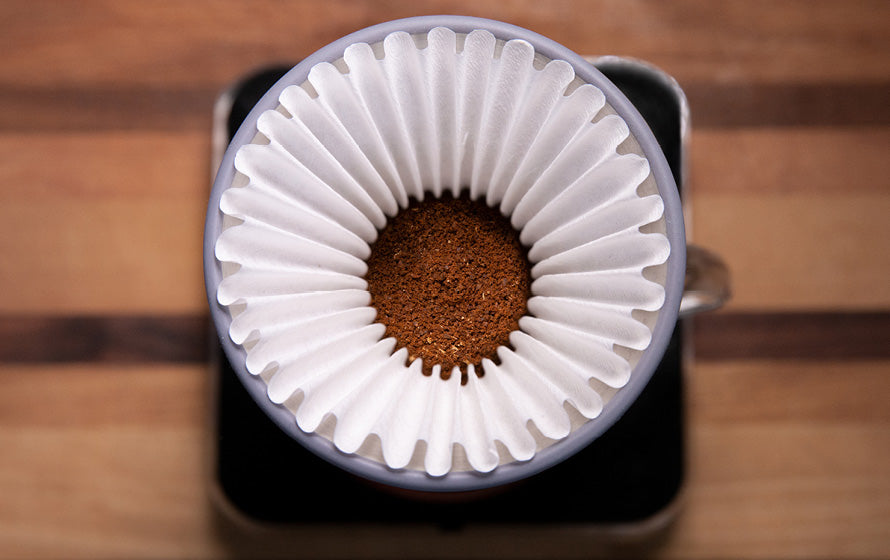Brewing coffee is a balancing act, and when you start using a new coffee maker, you’ve gotta do some rebalancing to make sure you still get all the great flavor you’re used to—and none of the bad stuff.
The first thing that needs rebalancing? Your coffee grind size.
Every coffee maker is designed to work best with a specific grind size. Once you find the right size for your brewer, you can reuse it over and over again and know you’ll hit that coffee flavor sweet spot.
You can use trial-and-error to find your coffee brewer’s perfect grind size, or you can just keep reading—we’ll walk through the ideal grind size pairings for the most common coffee makers so you can skip straight to delicious flavor.
We’ll touch on a few areas:
- How to pair your brewer with its perfect grind size
- Why some brewers (like the AeroPress) can use many grind sizes
- 3 extra tips for grinding to generate max flavor
The 4 Coffee Grind Sizes To Remember
When we talk about grind sizes, we typically use four key terms. Here’s the quick breakdown.
- Coarse — Large coffee grounds about the size of kosher salt. You can see the individual grounds pretty clearly at a quick glance.
- Medium — These grounds look more like coarse sand. They’ll feel a bit rough in your hand, but it’s harder to see the individual grounds at a quick glance.
- Fine — Roughly the size of table-salt. It’ll feel like a fine sand in your hand, soft, smooth, and consistent.
- Super-Fine — At this grind size, the coffee will feel more like a powder than a collection of individual coffee grounds.
We’re speaking in general terms here, because there’s no international standard for how coffee grounds are measured and categorized. One person’s coarse might be another person’s “medium-coarse”. The best thing to do is rely on your coffee grinder’s manual.
Read: The Definitive List of Every Type of Coffee
A coffee grinder with 40 settings might designate settings 20-30 as “medium” sizes—so which should you use? 20, 25, 29? The good news is, if you’re in the ballpark, you’ll end up with good tasting coffee. And once you’re there, you can experiment with a few different settings and use your senses to tell which one tastes better. We think it’s all part of the fun!
Let’s start looking at specific grind size and brewer pairings.
French Press Coffee Grind Size: Coarse
French press coffee is traditionally made with a coarse grind size, because the larger grounds aren’t as likely to slip through the steel mesh filter of the french press.
The coarse grind size, as a result, is what leads to the longer brewing time of the french press: usually around 4 minutes long. That’s because it takes longer for the hot water to seep into the grounds and extract all the yummy flavors you want in your final cup.
There are some people who like to use a medium-coarse grind setting and a shorter brew time (around 2:30), but the trade-off is that the smaller grounds end up in your final mug because they can slip through the filter.
🙌 Side note: we designed the ESPRO Press with a filter that’s ~12x finer than the standard french press filter, which means you never have to worry about grit or sludge in your final cup—even if you want to experiment with a medium-coarse setting.
Cold Brew Coffee Grind Size: Medium to Coarse
Cold brew coffee is most often made with a coarse grind size, using the “immersion” method of steeping grounds in cold water for 12+ hours. The reason for the coarse grind is that, when it’s time to filter the brewed coffee from the grounds, it doesn’t take hours (coarse grounds have lots of space in-between them compared to fine grounds, so the filtering is much faster).
If you use a French press to make your coffee, go with the coarse grind.
However, there’s also another “slow drip” style of cold brew coffee, where cold water slowly drips over coffee grounds over the course for 3-5 hours. The water will only drip for so long, so these brewers use a medium grind setting so the coffee can be fully extracted by the time the water runs out.
Read: Battle of the Brews: Hot, Iced, and Cold Brew Coffee Explained
Pour Over Coffee Grind Size: Medium-Fine to Medium-Coarse
There’s a lot of variation with pour over coffee makers. Some use paper filters, others use metal ones. Some are cone-shaped, others have flat bottoms. And they all work best with a different grind setting.
For example, the ESPRO Bloom Pour Over brewer has a flat-bottom metal filter, but can also be used with paper filters. If you brew with the built-in metal filter only, you’ll want to use a medium-coarse grind size to ensure the coffee doesn’t drain through the metal too slowly. However, if you use a paper filter, you’ll want to use a medium-fine grind size to slow down the draining speed slightly.
The Chemex uses a thick paper filter that slows down the draining of water significantly, so you’ll want to use a medium-coarse grind size.
The Hario V60 uses a thin paper filter that allows very fast draining, so you’ll be best off with a medium-fine grind size to help slow down the drain speed and prolong the brew time.
Read: French Press vs Pour Over Coffee: Discover Which Is Better For You
AeroPress Grind Size: Medium-Fine to Coarse
The AeroPress is a bit of an odd duck, because it’s capable of using many grind sizes. The cylindrical coffee maker uses a plunger to force hot water through the grounds, which means you can almost use any grind size you’d like—as long as you can still push the water through.
- French Press(ish) — Some recipes call for a coarse grind size and a long steep time (3-4 minutes), much like you’d use to make french press coffee.
- Espresso(ish) — Other recipes call for a medium-fine grind setting, a very short brew time (30 seconds), and a hefty push down of the plunger to create a “shot” of dense espresso-like coffee.
- In The Middle — Most recipes fall somewhere in-between, with a medium to medium-coarse setting, a modest brew time (1-2 minutes), and a mild push down of the plunger.
There’s a lot of flexibility with this brewer, so remember the core principles: the smaller the coffee ground, the less time it needs to brew.
Moka Pot Coffee Grind Size: Fine
Moka pots are classic Italian brewers that sit on top of your stove and create concentrated coffee that’s on the way to espresso, but not quite like a shot you’d get in your favorite cafe. That’s why they’re called stovetop espresso makers.
The brewer forces hot water vapor through fine coffee grounds to create the rich, syrupy brew, and anything bigger will end up tasting watery and weak.
Espresso Grind Size: Super-Fine
Espresso is made when hot water is forced through super-fine coffee grounds that are tightly packed in a portafilter at 8+ bars of pressure (powerful equipment required for this level of pressure).
The grounds have to be super-fine for the brewing to work. If the grounds are even just “fine”, the water will rush through without achieving any extraction (creating watery, weak coffee).
The confusing thing is, when we’re talking about coffee grounds this fine, even tiny changes to the size—so small you can’t see or feel the difference—can have dramatic impacts on the espresso shot’s flavor.
That’s why, for espresso, it’s ideal to use a dedicated espresso grinder that not only has 30-40 macro settings, but also additional micro-adjustments that essentially create 10+ extra mini settings in-between each macro setting.
3 Extra Coffee Grinding Tips For A+ Flavor
Now you know what grind size to pair your brewer with, but the actual how can be challenging. Use these simple tips to find your grind size sweet spot.
- Try a small range of grind sizes. Remember, “medium” is a generalized term that might be represented by 5-10 different settings on your grinder. We suggest brewing coffee at three evenly spaced settings within the proper range (settings 2, 5, and 8 for example) and using your taste buds to judge which one worked best.
- When you make adjustments, make small adjustments. Even if you find a grind setting that almost always works, you’ll inevitably run into a coffee here and there that tastes extra sour or extra bitter and needs a grind adjustment to bring the brew back to its flavor sweet spot. Big swings in grind settings will leave you more confused and frustrated—only change settings by 1-3 numbers at a time.
- Grind fresh, right before you brew. Ground coffee only has 20-30 minutes of peak freshness before it starts to lose its best flavors and aromas. That’s why we always recommend grinding just a couple of minutes before you’re ready to brew up your next mug.
Bonus Tip: Not all coffee makers are made equal, and some are more forgiving than others when it comes to your grind size. That’s one of the reasons we’re re-imaging coffee gear—because you don’t want to walk on eggshells with your morning routine. You just want it to work and be delicious.
👉 See how we’re making A+ coffee flavor easier and more reliable with our modern coffee brewing equipment.














